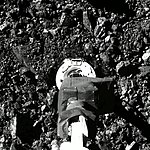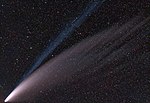오푸치우스 슈퍼클러스터 분화
Ophiuchus Supercluster eruptionNASA 등에[who?] 따르면, NeVe 1 은하의 Ophiuchus Supercluster 폭발은 MS 0735+74 폭발 이후 관측 가능한 우주에서 볼 수 있는 가장 큰 AGN 폭발이었다.[1][2][3]
| 이벤트 유형 | AGN 폭발 |
|---|---|
| 계기 | 찬드라 X선 관측소, XMM-뉴턴, 머치슨 와이드필드 어레이, 자이언트 메트루브 전파 망원경 |
| 별자리 | 오푸치우스 |
| 거리 | 3억 9천만 광년 |
이 극도로 정력적인 사건은 지구에서 약 3억 9천만 광년 떨어진 곳에 위치한 오피우쿠스 슈퍼클러스터에서 일어났다.이 폭발은 수억년에 걸쳐 초질량 블랙홀이 극도의 활성 입자의 분출물을 분사하면서 일어났다.[4][5]총 에너지는 5 × 1061 erg 또는 5 × 1054 J로 추정되지만, 이는 공동의 크기에 대한 불확실성으로 인해 과소평가될 가능성이 있다.[6]
This observation is a result of collaboration among various space-based and Earth-based observatories including the Hubble Space Telescope, the Chandra X-ray Observatory, ESA’s XMM Newton X-ray space observatory and radio data from the Murchison Widefield Array (MWA) in Australia and the Giant Metrewave Radio Telescope (GMRT) in India.[7][8]
참조
- ^ "Ophiuchus Galaxy Cluster". NASA. 27 February 2020. Retrieved 28 February 2020.
- ^ "Chandra Press Room :: Most Powerful Eruption in the Universe Discovered :: January 5, 2005". chandra.harvard.edu. Retrieved 2020-02-29.
- ^ "The AGN Outburst we won't call an explosion and a rock around the Earth The Daily Space". Retrieved 2020-12-09.
- ^ Werner, N.; Zhuravleva, I.; Canning, R. E. A.; Allen, S. W.; King, A. L.; Sanders, J. S.; Simionescu, A.; Taylor, G. B.; Morris, R. G.; Fabian, A. C. (August 2016). "Deep Chandra study of the truncated cool core of the Ophiuchus cluster". MNRAS. 460 (3): 2752–2764. Bibcode:2016MNRAS.460.2752W. doi:10.1093/mnras/stw1171. ISSN 0035-8711.
- ^ "Universe's Most Powerful Black Hole Eruption Spotted Astronomy Sci-News.com". Breaking Science News Sci-News.com. Retrieved 2020-12-09.
- ^ Giacintucci, S.; Markevitch, M.; Johnston-Hollitt, M.; Wik, D. R.; Wang, Q. H. S.; Clarke, T. E. (4 February 2020). "Discovery of a giant radio fossil in the Ophiuchus galaxy cluster". The Astrophysical Journal. 891 (1): 1. arXiv:2002.01291. Bibcode:2020ApJ...891....1G. doi:10.3847/1538-4357/ab6a9d. S2CID 211020555.
- ^ "Biggest cosmic explosion ever detected left huge dent in space". The Guardian. 27 February 2020. Retrieved 28 February 2020.
- ^ Giacintucci, S.; Markevitch, M.; Johnston-Hollitt, M.; Wik, D. R.; Wang, Q. H. S.; Clarke, T. E. (2020-02-04). "Discovery of a giant radio fossil in the Ophiuchus galaxy cluster". The Astrophysical Journal. 891 (1): 1. arXiv:2002.01291. Bibcode:2020ApJ...891....1G. doi:10.3847/1538-4357/ab6a9d. S2CID 211020555.






